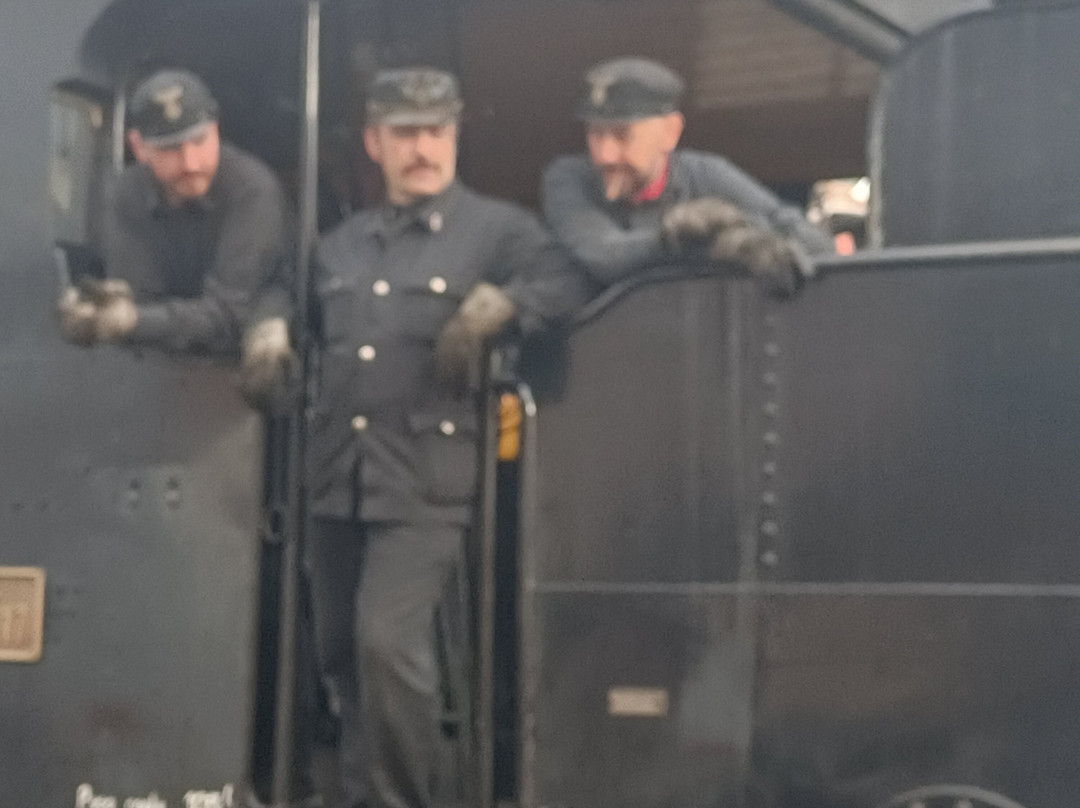的点评
Fascinating experience from many points of view.
Nature Train Tour的点评
点评:For the second time I traveled on the “Treno natura” in the Siena area. But the first time was many years ago, and the route was different from the one we taken now. I remember that we had traveled – in any case on a train pulled by a steam locomotive – from Siena to Monte Antico, we had stopped for a long time at the latter station, with the possibility of trekking, having lunch in the surrounding area, etc.. Finally we returned to Siena.
In the time elapsed between my first trip and the second and last, the “Treno natura” initiative has evolved. First of all, it is now included among the activities sponsored by “Fondazione FS”: a foundation aiming to coordinating initiatives on “nostalgic trains” throughout all of Italy. Furthermore, the initiatives have become more frequent, and they are very successful: almost all the trains are fully-booked.
I cannot cite the sources, but I know for sure that the nostalgic trains organized by the Siena office are the most numerous, and move a greater quantity of passengers than any other area in Italy.
Since this result is not obvious (southern Tuscany is one of the least populated areas of Italy), an explanation is required. In my opinion there are two reasons.
The first reason is the availability, in southern Tuscany, of a long railway (51 km), from Asciano to Monte Antico, closed to normal passenger and freight traffic, yet in good condition, and connected at both ends with Siena, by railway sections that are still active (but not overloaded with traffic). This favors the operation of a large number of nostalgic trains, which cross the beautiful landscape of central Tuscany.
The second reason is in my opinion the presence of a social milieu favorable to this enhancement of the disused lines, which has produced the active commitment of the Administration of the Province of Siena, the Municipality of Siena, and the other municipalities affected by the routes. For example, the nostalgic trains are held at the same time as fairs, market exhibitions, sales of typical products, etc., in the municipalities adjacent to the line.
In our case, the final destination of the train journey from Siena was the hamlet of Vivo d’Orcia (about 900 m above sea level), on the slopes of Monte Amiata, for the “Sagra delle castagne e dei funghi”, ie chestnuts and mushrooms, typical products of October. From the station called “Monte Amiata” the buses transported the almost 400 train passengers to Vivo d’Orcia, and in the afternoon they transported them again to the “Torrenieri” station, from where the steam train returned to Siena.
In Vivo d’Orcia the passengers had about 5 hours of free time. We – unlike the majority who had booked a lunch in the village – equipped with a packed lunch, did a circular hiking trail of about 5 kms, and therefore enjoyed the landscape, both natural and cultural, of the area.
Much of the enjoyment that nostalgic train users will draw from their experience is therefore in their own hands, as our case demonstrates.
In the time elapsed between my first trip and the second and last, the “Treno natura” initiative has evolved. First of all, it is now included among the activities sponsored by “Fondazione FS”: a foundation aiming to coordinating initiatives on “nostalgic trains” throughout all of Italy. Furthermore, the initiatives have become more frequent, and they are very successful: almost all the trains are fully-booked.
I cannot cite the sources, but I know for sure that the nostalgic trains organized by the Siena office are the most numerous, and move a greater quantity of passengers than any other area in Italy.
Since this result is not obvious (southern Tuscany is one of the least populated areas of Italy), an explanation is required. In my opinion there are two reasons.
The first reason is the availability, in southern Tuscany, of a long railway (51 km), from Asciano to Monte Antico, closed to normal passenger and freight traffic, yet in good condition, and connected at both ends with Siena, by railway sections that are still active (but not overloaded with traffic). This favors the operation of a large number of nostalgic trains, which cross the beautiful landscape of central Tuscany.
The second reason is in my opinion the presence of a social milieu favorable to this enhancement of the disused lines, which has produced the active commitment of the Administration of the Province of Siena, the Municipality of Siena, and the other municipalities affected by the routes. For example, the nostalgic trains are held at the same time as fairs, market exhibitions, sales of typical products, etc., in the municipalities adjacent to the line.
In our case, the final destination of the train journey from Siena was the hamlet of Vivo d’Orcia (about 900 m above sea level), on the slopes of Monte Amiata, for the “Sagra delle castagne e dei funghi”, ie chestnuts and mushrooms, typical products of October. From the station called “Monte Amiata” the buses transported the almost 400 train passengers to Vivo d’Orcia, and in the afternoon they transported them again to the “Torrenieri” station, from where the steam train returned to Siena.
In Vivo d’Orcia the passengers had about 5 hours of free time. We – unlike the majority who had booked a lunch in the village – equipped with a packed lunch, did a circular hiking trail of about 5 kms, and therefore enjoyed the landscape, both natural and cultural, of the area.
Much of the enjoyment that nostalgic train users will draw from their experience is therefore in their own hands, as our case demonstrates.
翻译:这是我第二次乘坐锡耶纳地区的“Treno natura”列车。但第一次是在很多年前,当时的路线与我们现在走的路线不同。我记得我们曾经乘坐蒸汽机车牵引的火车从锡耶纳前往蒙特安蒂科,我们在后者的车站停留了很长时间,有机会徒步旅行、在周边地区吃午饭等。最后我们回到了锡耶纳。
在我第一次旅行和第二次也是最后一次旅行之间,“Treno natura”计划已经发展起来。首先,它现在被列入“Fondazione FS”赞助的活动之中:该基金会旨在协调整个意大利的“怀旧列车”计划。此外,这些活动变得更加频繁,而且非常成功:几乎所有的火车都订满了。
我无法引用来源,但我确信锡耶纳办事处组织的怀旧列车数量最多,运送的乘客数量比意大利其他任何地区都多。
由于这个结果并不明显(托斯卡纳南部是意大利人口最少的地区之一),因此需要解释一下。我认为有两个原因。
第一个原因是托斯卡纳南部有一条长铁路(51 公里),从阿夏诺到蒙特安蒂科,这条铁路禁止正常的客运和货运,但状况良好,两端与锡耶纳相连,铁路段仍在运行(但没有超载)。这有利于大量怀旧列车的运行,这些列车穿越托斯卡纳中部的美丽风景。
第二个原因是,我认为存在有利于改善废弃线路的社会环境,这引起了锡耶纳省政府、锡耶纳市政府和其他受路线影响的市政府的积极承诺。例如,怀旧列车与线路附近市镇的集市、市场展览、特色产品销售等同时举行。
在我们的案例中,从锡耶纳出发的火车之旅的最终目的地是维沃多尔恰 (Vivo d’Orcia) 小村庄(海拔约 900 米),位于蒙特阿米亚塔 (Monte Amiata) 的山坡上,那里有“Sagra delle castagne e dei funghi”,即栗子和蘑菇,这是十月的典型产品。从名为“蒙特阿米亚塔”的车站出发,巴士将近 400 名火车乘客运送到维沃多尔恰,下午又将他们运送到“Torrenieri”车站,蒸汽火车从那里返回锡耶纳。
在维沃多尔恰,乘客有大约 5 小时的空闲时间。我们与大多数在村里预订午餐的人不同,我们带了盒装午餐,沿着一条约 5 公里的环形徒步路线徒步,欣赏了该地区的自然和文化景观。
正如我们的案例所示,怀旧火车乘客从他们的体验中获得的大部分乐趣都掌握在他们自己手中。
在我第一次旅行和第二次也是最后一次旅行之间,“Treno natura”计划已经发展起来。首先,它现在被列入“Fondazione FS”赞助的活动之中:该基金会旨在协调整个意大利的“怀旧列车”计划。此外,这些活动变得更加频繁,而且非常成功:几乎所有的火车都订满了。
我无法引用来源,但我确信锡耶纳办事处组织的怀旧列车数量最多,运送的乘客数量比意大利其他任何地区都多。
由于这个结果并不明显(托斯卡纳南部是意大利人口最少的地区之一),因此需要解释一下。我认为有两个原因。
第一个原因是托斯卡纳南部有一条长铁路(51 公里),从阿夏诺到蒙特安蒂科,这条铁路禁止正常的客运和货运,但状况良好,两端与锡耶纳相连,铁路段仍在运行(但没有超载)。这有利于大量怀旧列车的运行,这些列车穿越托斯卡纳中部的美丽风景。
第二个原因是,我认为存在有利于改善废弃线路的社会环境,这引起了锡耶纳省政府、锡耶纳市政府和其他受路线影响的市政府的积极承诺。例如,怀旧列车与线路附近市镇的集市、市场展览、特色产品销售等同时举行。
在我们的案例中,从锡耶纳出发的火车之旅的最终目的地是维沃多尔恰 (Vivo d’Orcia) 小村庄(海拔约 900 米),位于蒙特阿米亚塔 (Monte Amiata) 的山坡上,那里有“Sagra delle castagne e dei funghi”,即栗子和蘑菇,这是十月的典型产品。从名为“蒙特阿米亚塔”的车站出发,巴士将近 400 名火车乘客运送到维沃多尔恰,下午又将他们运送到“Torrenieri”车站,蒸汽火车从那里返回锡耶纳。
在维沃多尔恰,乘客有大约 5 小时的空闲时间。我们与大多数在村里预订午餐的人不同,我们带了盒装午餐,沿着一条约 5 公里的环形徒步路线徒步,欣赏了该地区的自然和文化景观。
正如我们的案例所示,怀旧火车乘客从他们的体验中获得的大部分乐趣都掌握在他们自己手中。

此点评仅代表旅行者个人的主观意见,并不代表TripAdvisor以及其合作方的意见。
关于我们
|
新闻动态
|
商务合作
|
会员中心
|
业主中心
|
业主通
|
常见问题
|
意见反馈
|
联系我们
|
营业执照
© 2025 Tripadvisor 版权所有。
使用条款 |隐私政策 |网站工作原理
部分照片由 VFM Leonardo 提供。
* Tripadvisor不是旅行社,也不是旅游预订服务代理商。我们提供免费、客观、公正的旅游资讯服务。 (显示更多)
TripAdvisor LLC 既不是预订代理商,也不是旅游运营商,不会向网站用户收取任何服务费。 按照规定,在 Tripadvisor 发布机票价格、游览和旅行套餐的合作伙伴(航空公司、旅行提供商及预订代理商),其标价须包含所有费用和附加费用。 例如, 机场出入境税费、消费税与其他服务费、手续费、杂费及附加费用。 当您向我们的某个合作伙伴进行预订时,请务必查阅他们的网站以了解当地行政部门要求的所有适用费用的具体情况。 除非另有说明,机票价格通常指的是一个人的价格(以人民币计)。
为方便起见,TripAdvisor LLC 根据从我们的预订合作伙伴获取的空房率计算每个酒店的均价。 对于游览和景点来说,所显示价格通常是每位成人的最低可用价格。 对于列出的任何旅行套餐或优惠,TripAdvisor LLC 无法保证任何特定的费率或价格。 此外,酒店均价每晚会更新,并以您的首选币种表示(使用现行汇率)。 由于这些已换算的价格是预估价格,因此,有关具体金额和币种请与预订网站进行核实。
此外,TripAdvisor LLC 无法保证我们网站上宣传的价格随时有效。 标价可能需要预订一定天数才能生效,或有不可用日期、使用条件或限制。
TripAdvisor公司对外部网站的内容一概不负责。优惠价格中不含税和其他费用。
ICP证:沪B2-20200433
沪ICP备20013175号
 沪公网安备31010502005427号
沪公网安备31010502005427号鹰程信息技术(上海)有限公司
货币/国家及地区
¥CNY
中国

